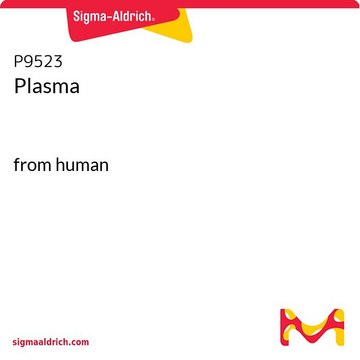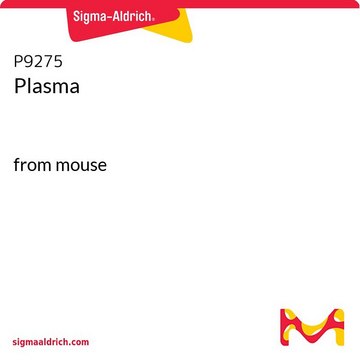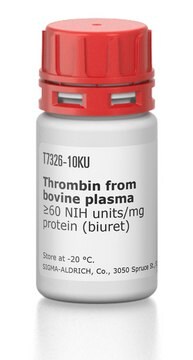Recommended Products
biological source
chicken
Quality Level
form
powder
contains
3.8% trisodium citrate as anticoagulant
storage temp.
2-8°C
Looking for similar products? Visit Product Comparison Guide
General description
Plasma is the liquid part of the blood and lymphatic fluid, which makes up about half of its volume. Plasma is devoid of cells and, unlike serum, has not clotted. It is prepared from whole blood that is collected with anticoagulants (9:1) and centrifuged to remove cells and cellular debris. Some of the more common proteins found in plasma are albumin and prealbumin, α1-acid glycoprotein, transferrin, lipoproteins (HDL, LDL, and VLDL), immunoglobulins, complement proteins, and coagulation proteins (thrombin, plasminogin, and fibrinogen). Citrated plasma contains citrate (3.8% trisodium citrate) as an anticoagulant.
Plasma contains a variety of proteins with diverse functions. The primary functions of the plasma proteins include the maintenance of colloid osmotic pressure, pH, and electrolyte balance; the transport of metal ions, fatty acids, steroids, hormones, and drugs to various organs of the body; use as a source for amino acids for tissue nourishment; hemostasis and the prevention of thrombosis; the regulation of cellular activity and function through hormone signaling; and defense against invasion through the actions of antibodies and complement components.
Plasma contains a variety of proteins with diverse functions. The primary functions of the plasma proteins include the maintenance of colloid osmotic pressure, pH, and electrolyte balance; the transport of metal ions, fatty acids, steroids, hormones, and drugs to various organs of the body; use as a source for amino acids for tissue nourishment; hemostasis and the prevention of thrombosis; the regulation of cellular activity and function through hormone signaling; and defense against invasion through the actions of antibodies and complement components.
Application
Plasma has been used to maintain steroid hormones. It has also been used for coagulation purpose in primary cerebellar slice cultures and chicken embryos slices.
Other Notes
This product is prepared from pooled chicken blood. It contains 3.8% trisodium citrate as an anticoagulant. It is tested for clotting, which indicates that the clotting factors in the product are active. However, it is not analyzed to determine whether other enzymes present are native or denatured. The resulting plasma is 0.45 microm filtered and lyophilized from the indicated volume.
Preparation Note
Whole blood collected with anticoagulants (9:1), pooled, and centrifuged. The resulting plasma is 0.45 μm filtered and lyophilized from the indicated volumes.
Storage Class
11 - Combustible Solids
wgk_germany
WGK 3
flash_point_f
Not applicable
flash_point_c
Not applicable
Choose from one of the most recent versions:
Already Own This Product?
Find documentation for the products that you have recently purchased in the Document Library.
Customers Also Viewed
Use of ethanol for preserving steroid and indoleamine hormones in bird plasma
Goymann W, et al.
General and Comparative Endocrinology, 150(2), 191-195 (2007)
Combination of in ovo electroporation and time-lapse imaging to study migrational events in chicken embryos
Masyuk M, et al.
Developmental Dynamics, 243(5), 690-698 (2014)
David Forsberg et al.
Current protocols in stem cell biology, 42, 2D-2D (2017-08-15)
Re-formation or preservation of functional, electrically active neural networks has been proffered as one of the goals of stem cell-mediated neural therapeutics. A primary issue for a cell therapy approach is the formation of functional contacts between the implanted cells
Annie Gott et al.
PeerJ, 6, e5842-e5842 (2018-10-30)
The strength of the avian stress response declines with age. A recently published study of European starlings (Sturnus vulgaris) found that a marker of biological age predicted the strength of the stress response even in individuals of the same chronological
Leonard Herrfurth et al.
Frontiers in molecular neuroscience, 10, 2-2 (2017-02-15)
Vascular endothelial growth factor (VEGF) is well known as the growth factor with wide-ranging functions even in the central nervous system (CNS). Presently, most attention is given to the investigation of its role in neuronal protection, growth and maturation processes
Our team of scientists has experience in all areas of research including Life Science, Material Science, Chemical Synthesis, Chromatography, Analytical and many others.
Contact Technical Service








